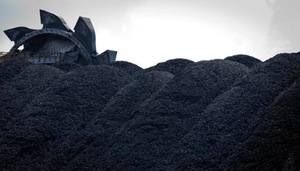
Environment and health groups have called for a rapid crackdown on air pollution after a new analysis showed that emissions of a key pollutant linked to respiratory illness have doubled over the past five years.
A study of the federal government’s annual national pollutant inventory, which was released this week, showed that 435,000 tonnes of a type of fine particle called PM10, named because it is just 10 micrometres in diameter, was emitted by coal companies in 2012-13.
This level of pollution represents a doubling in PM10 emissions in the past five years, according to Environmental Justice Australia, which compiled the comparative figures. The inventory covers dozens of pollutants emitted by more than 4,300 heavy industry facilities across Australia.
The 10 highest emitting mines increased their PM10 output by between 48% and 1,030% over the past five years, with hotspots including the Latrobe Valley in Victoria, where PM10 levels increased by 27% over five years, and the Hunter Valley in New South Wales.
The increase in PM10, which Environmental Justice Australia puts down to an increase in mining activity, was accompanied by increases in lead, arsenic and fluoride emissions over the past five years.
PM10, and other fine particles released from dirt, soot and smoke, have been linked to a number of health problems, including asthma, bronchitis and heart disease.
While the level of pollution has increased, it appears to have not caused a corresponding spike in breaches of national air pollution standards, which demand there be no more than five days a year when PM10 is measured at above 50 micrograms per cubic metre in any one location.
In NSW, there were four places in the Hunter Valley and Newcastle that breached this safe level in 2014, compared to eight in 2013. In Victoria, just two places breached the limit in 2013.
However, a collection of environment and health groups, including the Climate and Health Alliance, Environment Victoria and the Nature Conservation Council of NSW, said the rise in pollution demands strict new standards.
Nicola Rivers, director of advocacy and research at Environmental Justice Australia, said that air pollution contributes to around 3,000 deaths in Australia each year, more than from car accidents.
“The standards are not set at levels that are safe for human health and they only monitor certain places with populations over 25,000 people,” she said. “The increase in PM10 is really alarming.
“Every tonne of pollutant you reduce, there are clear health benefits, as has been shown by many studies around the world. We need national clean air laws as the current standards are clearly failing. We need binding national laws requiring these coal companies to emit less.”
Rivers said that Greg Hunt, the federal environment minister, had shown “leadership” on the issue, but that more should be done.
Hunt is working with state governments to strike a national clean air agreement by next year, which would set tougher standards for certain pollutants.
“Air quality in Australia is very good by world standards but it could be better, and over the coming decades as the population grows, we need to make sure that our air quality improves,” a spokesman for Hunt said.
“The national clean air agreement will focus on actions to reduce air pollution and improve air quality through cooperative action between industry and government at the national, state and local level. It will also incorporate a range of existing, new and complementary measures to improve Australia’s air quality.”
A discussion paper released for the agreement states that there should be stronger air quality standards for sulphur dioxide, nitrogen dioxide and ozone, tackling the release of mercury into the environment and curbing shipping emissions.
The health toll of air pollution costs Australia up to $24.3bn a year. Around 2.2% of hospital emissions for children aged under 14 with respiratory problems are due to PM10.
